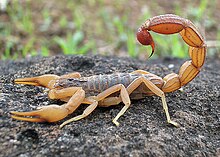|
Hottentotta tamulus
Hottentotta tamulus, the Indian red scorpion, also known as the eastern Indian scorpion, is a species of scorpion of the family Buthidae. It occurs in most of India,[2] eastern Pakistan[1] and the eastern lowlands of Nepal,[3] and recently from Sri Lanka.[4] TaxonomyThis species was named Scorpio tamulus by J.C. Fabricius in 1798.[5] The species name was apparently derived from the occurrence in the state/province of the Tamil people of southeastern India. It was later often referred to the genera Buthus or Mesobuthus, although it was already correctly placed in Hottentotta by A. A. Birula in 1914,[6] a referral that was confirmed again by F. Kovařík in 2007.[1] Nevertheless, the binomen Mesobuthus tamulus is traditionally widespread in the popular and scientific literature. R.I. Pocock (1900)[7] distinguished five subspecies according to coloration and distribution, but these are color-morphs (individuals with varying color) rather than subspecies.[1] Description Total body length is about 50 to 90 mm. Males with flexed proximal margins of pedipalp fingers. Manus of pedipalps is also wider than female. There are 30 to 39 pectinal teeth in males, and 27 to 34 in females. Chelicerae are yellow and reticulated. Pedipalps are densely hirsute, whereas legs and metasoma are sparsely hirsute. Patella of pedipalps covered with short setae. Mesosoma is darker than rest of the body. Ventral carinae on metasomal segments are black. Chela without carinae. Dorsum densely and very finely granulated. Dorsum bears two short, inconspicuous marginal carinae. Telson is granulated.[8] The walking legs and the tip of the pedipalp pincers are bright orange-yellow to light reddish-brown in color. The mesosomal tergites always bear three distinct carinae. Their habitus is typical of buthid scorpions, with rather small pedipalp pincers, moderately thickened metasomal segments and a rather bulbous telson with large stinger. The base of the pedipalp pincers (manus) is slightly more inflated in males than in females.[1] ToxicityThis species is of great medical significance in densely populated areas of India and Nepal and occasionally causes human fatalities.[3][9][10] Fatality rates of 8–40% have been reported in clinical studies; most victims are children.[9][11] Symptoms of envenomation by this species include:[3][9][10][12]
The venom mainly affects the cardiovascular and pulmonary system, eventually leading to a pulmonary oedema, which may cause death.[9][10] Scorpion antivenom has little effect in clinical treatment but application of prazosin reduces the mortality rate to less than 4%.[10][13] As in other scorpions, the venom of H. tamulus consists of a complex mixture of proteins. Some major components have been isolated, including the toxin tamapin. Scorpion envenomation with high morbidity and mortality is usually due to either excessive autonomic activity and cardiovascular toxic effects or neuromuscular toxic effects. Antivenin is the specific treatment for scorpion envenomation combined with supportive measures including vasodilators in patients with cardiovascular toxic effects and benzodiazepines when there is neuromuscular involvement. Although rare, severe hypersensitivity reactions including anaphylaxis to scorpion antivenin (SAV) are possible.[14] Habitat and ecologyDespite its medical importance, little is known about the ecology and habitat preferences of this species.[10] It is widespread across vegetated lowlands with subtropical to tropical, humid climate and often lives close to or in human settlements, especially in rural areas. A study[15] from Saswad-Jejuri, Pune (western India) has found H. tamulus in a wide range of microhabitats, including scrubland and veld with stones, red and black soil in cropland, loamy, grassy and stony hillslopes and -tops, black soil in mango orchards, Eucalyptus plantations, and under tree bark. With an abundance of 48.43% it was by far the most abundant of the six scorpion species recorded in this study. It occurs rather seldom under tree bark, a habitat dominated by its sister species Hottentotta pachyurus (8.9% versus 91.1% abundance). As all other scorpions, H. tamulus is nocturnal, preying upon small invertebrates and even small vertebrates like lizards.[16] Encounters with humans mainly occur during the night or early morning, when the scorpions accidentally crawl into beds or fall from ceilings.[10] In Sri LankaOriginally, H. tamulus was not found in Sri Lanka. But from 2010 to 2013, experiments and other medical reports suggest that the species is also present in Sri Lanka.[4] Few deaths were recorded from Jaffna peninsula in recent times. After observing medical reports and patients, a research team found three dead scorpion specimens and five live specimens as well. After series of observations from research team and other international scientists, it was revealed that the scorpion specimens belong to the species H. tamulus. Deaths from H. tamulus were recorded in 2006, 2007 and 2009 as one patient per year. No cases were recorded in 2010. In 2011, 12 children in Jaffna died due to H. tamulus stings. In 2012, 80 patients were recorded. Out of them, 52% were female, 48% were male. 30% from them were children between the age 3 and 12.[4] In 2013, many H. tamulus stings were recorded, as many as four each week, again mostly in women and children. Usually, the drug Prazosin is recommended for H. tamulus stings. The drug can reduce the increasing blood pressure. See alsoNotes
References
External linksWikimedia Commons has media related to Hottentotta tamulus.
|
||||||||||||||||||||||||||||||||||
